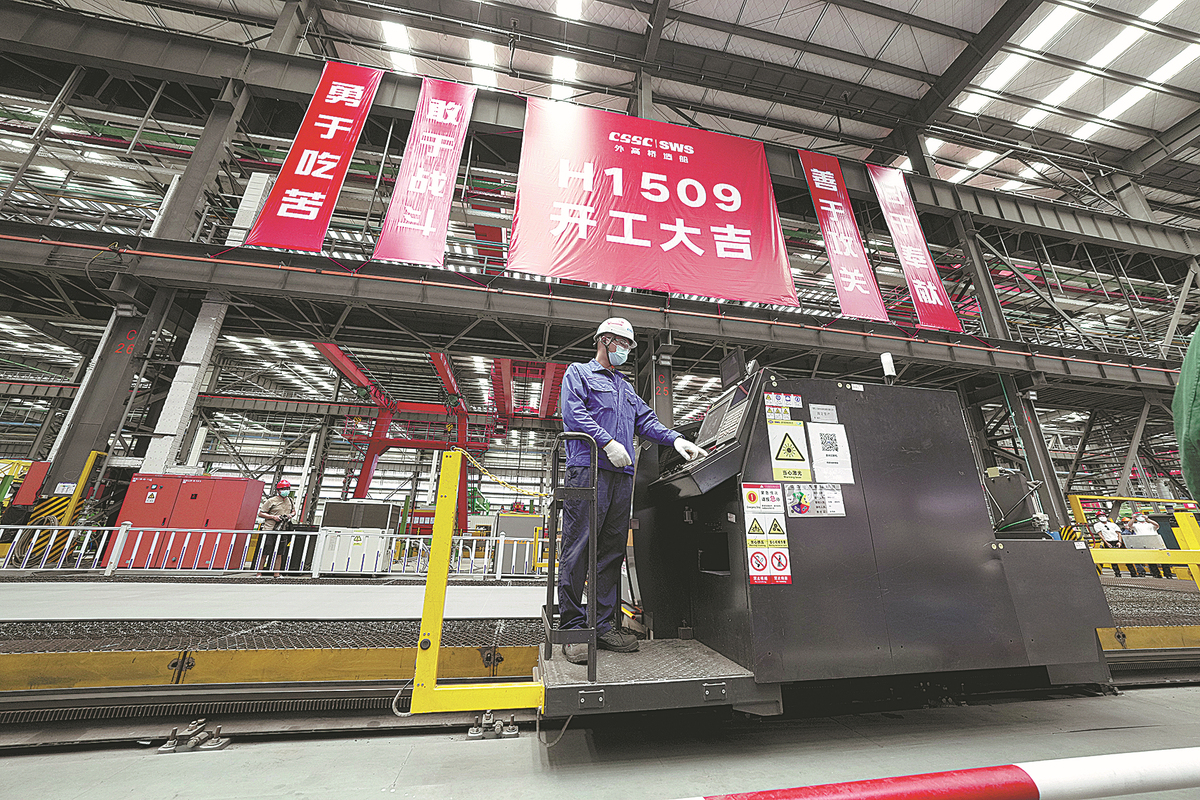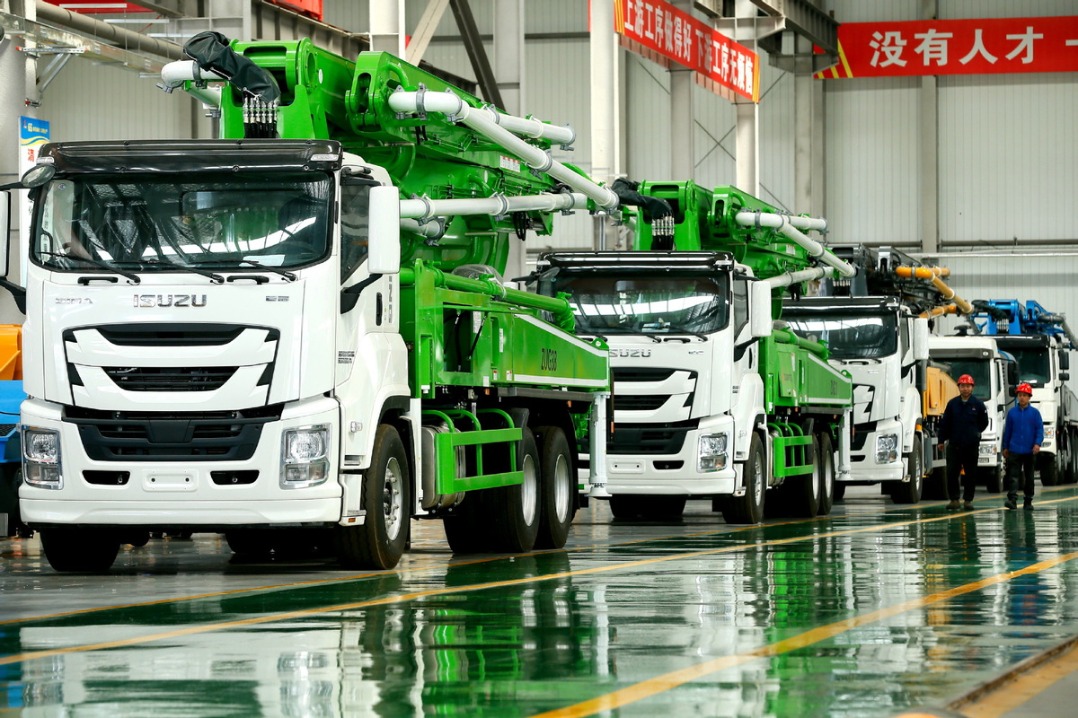Country's shipbuilders to enter new era of high growth


China's State-owned shipbuilders are expected to enter a high-growth period this year, driven by global markets' soaring demand for high-end and environmentally friendly vessels as well as the recovery of China's marine economy, according to experts and business leaders.
China remained the world's leading shipbuilder in the first seven months, with its market share ranking tops globally in output and in new and pending orders.
The country's shipbuilding output hit 20.85 million deadweight tons in the January-July period, accounting for 44.4 percent of the world's total, according to Beijing-based China Association of the National Shipbuilding Industry (CANSI). Deadweight is often used to specify a ship's maximum permissible weight.
New shipbuilding orders, another major indicator in the shipbuilding industry, came in at 25.72 million deadweight tons during the period, representing 51.1 percent of global market share.
"Rising freight rates and shipping demand have notably boosted both revenue and profit growth of global shipping and energy companies, such as Switzerland-based Mediterranean Shipping Co (MSC), Germany's Hapag-Lloyd and QatarEnergy, formerly known as Qatar Petroleum, over the past two years," said Tan Naifen, deputy secretary-general of CANSI.
She said that many companies have accelerated the phasing out of their older ships with high fuel emissions in order to buy new, advanced vessels-mainly containerships, oil tankers and bulk vessels-that meet requirements of the United Nations' international maritime organization to cut carbon emissions in the global shipping business.
"Therefore, dual-fuel engines, and engines powered by liquefied natural gas and liquefied petroleum gas, have become popular choices for global shipowners," she said, adding that China exported $11.77 billion in vessels of different types from January to July.
Hudong-Zhonghua Shipbuilding (Group) Co Ltd, a Shanghai-based subsidiary of China State Shipbuilding Corp Ltd (CSSC), delivered a mega-container carrier from its Changxing shipyard to MSC in Shanghai in early August.
The containership has a capacity of more than 240,000 metric tons of cargo in 24,116 twenty-foot equivalent containers at one time, which is the largest capacity of its kind in the world.
The ship's delivery indicated that China has entered a new era in the container carrier building industry, experts said. The company will deliver another three containerships of that type in the coming months, the shipbuilder said in a statement.
The container carrier, independently designed by the State-owned company, was registered with DNV, an international marine industry registrar and classification society headquartered in Norway. It is 400 meters long, more than 60 meters longer than the world's largest aircraft carrier, and 61.5 meters wide. Its deck covers an area equivalent to nearly four standard soccer fields.
China's shipbuilding holding orders rose 15.6 percent year-on-year to 103.66 million deadweight tons by the end of July, with a global market share reaching 48.1 percent, according to CANSI.
Shanghai Waigaoqiao Shipbuilding Co Ltd, another CSSC subsidiary, began the construction of China's second domestically built cruise ship in early August.
The second vessel will not be a duplication of the first ship, said Zhou Qi, the company's vice-president.
The 142,000-gross-ton vessel will measure 341 meters long, or 17.4 meters longer than the first version, and 37.2 meters wide. It will have 2,144 passenger cabins, 19 cabins more than the first.
By meeting the latest international standards for emissions, the second cruise vessel will be a greener floating city and hopefully provide a better experience for passengers with a high level of safety and comfort, he said.
The first domestically built large cruise ship was launched at the shipyard of Shanghai Waigaoqiao Shipbuilding in December. The ship is in the second half of its interior finishing and system debugging.
CSSC signed a contract with the world's biggest cruise operator by fleet size, Carnival Corp & Plc, based in Florida, the United States, and Italy's Fincantieri, Europe's largest builder of cruise ships in terms of market share, to build two cruise ships, with an option for building an additional four vessels. The deal was sealed in 2018 during the first China International Import Expo in Shanghai.
To accomplish these goals, Carnival has teamed up with CSSC to establish a Shanghai-based cruise joint venture called CSSC Carnival Cruise Shipping Ltd and announced plans to dedicate the first two made-in-China cruise ships to the Chinese market.
Meanwhile, CSSC-Fincantieri Cruise Industry Development Ltd was formed as a joint venture between CSSC and Fincantieri to work on the design of cruise ships.
After the ships are built, they will be delivered to the CSSC Carnival joint venture, which will be responsible for providing expertise in cruise management and operations.
With a long industrial chain, the development of the cruise industry in China will raise the standards for the modern service industry and promote the whole marine economy, said Tian Yulong, chief engineer of the Ministry of Industry and Information Technology.
China's marine economy recovered steadily in the first half of 2022, as the country has been striving to respond to the COVID-19 pandemic and pursue economic and social development in a well-coordinated manner, according to the Ministry of Natural Resources.
The country's gross ocean product grew 1.2 percent year-on-year to 4.2 trillion yuan ($604.9 billion) in the first half, according to preliminary calculations. The gross ocean product is the sum of the added value of marine and marine-related industries. Its marine foreign trade also rose steadily, with the total value of seaborne imports and exports jumping 18.2 percent year-on-year.




































